Guinea |
|
|
|
| Übersicht – Contents: | |
Guinea |
|
|
|
| Übersicht – Contents: | |
Flaggen – Flags: |
|
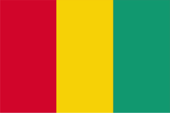 |
Nationalflagge – national flag, Seitenverhältnis – ratio = 2:3, Quelle/Source, nach/by: Wikipedia (D) |
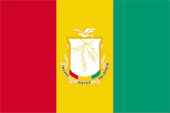 |
seit/since 1994, |
historische Flaggen – historical Flags: |
|
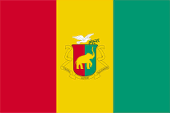 |
bis/to 1984, |
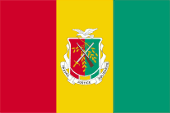 |
1984–1993, |
Bedeutung/Ursprung der Flagge – Meaning/Origin of the Flag: |
|
| Die Flagge wurde am 10.11.1958 offiziell eingeführt. Sie ist in drei senkrechte Streifen untergliedert, und orientiert sich damit, wie viele ehemalige französische Kolonien, an der Flagge des Mutterlandes Frankreich, an der Trikolore. Die Farbe Rot steht für das im Freiheitskampf vergossene Blut, Gelb für die Sonne und die Bodenschätze des Landes, Grün für die Vegetation und die Landwirtschaft. Die Farbtöne der Flagge sind wahrscheinlich nicht per Gesetz festgelegt. Sie scheinen aus der Praxis heraus definiert zu sein, und zwar als Grün = Pantone 340, Gelb = Pantone 116, Rot = Pantone 186. | The flag
was officially introduced on 10th of November in 1958. It is divided into
three vertical stripes and is with this orientated in the flag of the
mother-land France - in the Tricolor - in this way done in many former
French colonies. The colour red stands for the in the fight for freedom
given blood, yellow stands for the sun and the natural resources of the
land, green stands for the vegetation and the agriculture. The colour shades of the flag are probably not defined by law. They seem to be defined by practice as green = Pantone 340, yellow = Pantone 116, red = Pantone 186. |
| Die Farbkombination von Grün, Gelb und Rot in der heutigen Flagge sind die Panafrikanischen Farben: Etwa 1900 setzte die Panafrika - Bewegung ein, die Gemeinsamkeiten aller Menschen mit schwarzer Hautfarbe hervorheben wollte. Für die politische Einheit Afrikas steht der Farbendreiklang Grün-Gelb-Rot, den viele afrikanische Staaten nach Erlangung ihrer Unabhängigkeit in ihre Flaggen übernahmen. Das erste Land war Ghana im Jahr 1957. Als Ursprung gelten die Landesfarben von Athiopien (Abessinien), dem ältesten unabhängigen Staat Afrikas. | The
combination of the colours green, yellow and red in the today's flag are the
Pan-African colours: Perhaps in 1900 was the beginning of the
Panafrica-Movement, wich wants to emphasize the commons of all people with
black skin. For the political unity of Africa stands the colour-triad green-yellow-red, wich used many african countries in their flags after the independence. The first country was Ghana in 1957. As the origin apply the colours of Ethiopia (Abessinia), the oldest independent state in Africa. |
| Quelle/Source, nach/by: Wikipedia (D), Die Welt der Flaggen, Flaggen Wappen Hymnen, Wikipedia (EN) | |
Wappen – Coat of Arms: |
|
 |
seit/since 1997, Wappen von Guinea – coat of arms of Guinea, Quelle/Source, nach/by: Wikipedia (FR) |
 |
1984–1993, Wappen von Guinea – coat of arms of Guinea, Quelle/Source: Corel Draw 4, Wikipedia (FR) |
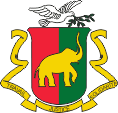 |
1958–1984, Wappen von Guinea – coat of arms of Guinea, Quelle/Source, nach/by: Flags of the World, Wikipedia (FR) |
Bedeutung/Ursprung des Wappens – Meaning/Origin of the Coat of Arms: |
|
| Als
Guinea im Jahr 1958 unabhängig wurde, wurde ein Staatswappen in den Farben
Rot, Grün und Gelb eingeführt. Das sind die Panafrikanischen Farben, aber
auch die Farben der Parti Democratique de Guinee (PDG), der Partei,
die Guinea in die Unabhängigkeit geführt hat. Der Schild war senkrecht
rot-gelb gespalten, und darauf ein grüner Elefant aufglegt. Der Elefant
wurde "Sili" genannt, und stammte vom Emblem der PDG. Oberhalb des Schildes
eine grüne Taube mit einem Olivenzweig im Schnabel. Der Rest des Schildes
war von einen grünen Spruchband umgeben, der unterhalb des Schildes das
Staatsmotto zeigte: "Travail - Justice - Solidarité" → "Arbeit - Gerechtigkeit - Solidarität". |
As Guinea
get independent in the year 1958, was introduced a coat of arms in the
colours red, green and yellow. These are the Pan-African colours, but even
the colours of the Parti Democratique de Guinee (PDG), those party
which Guinea lead into the independence. The blazon was vertically clefted
in red and yellow and thereupon was layed down a green elephant. The elephant
was named "Sili" and descends from the emblem of the PDG. Above the blazon a
green pigeon with an olive twig in the mouth. The remaining border of the blazon was surrounded by a green ribbon which below the blazon showed the motto of the state: "Travail - Justice - Solidarité" → "Work - Justice - Solidarity". |
| Das heutige Staatswappen wurde im Jahre 1985 in Folge des Machtwechsels von 1984 eingeführt. Dazu wurde das bisherige Staatswappen wie folgt abgeändert: Der Elefant wurde entfernt, an seine Stelle traten Schwert und Gewehr, vor einem großen Olivenzweig gekreuzt, den die jetzt nach links fliegende weiße Taube noch immer im Schnabel hält. Der Schild trägt an seinem unteren Ende eine Verlängerung in den Landesfarben, die bis an das vereinfachte, nun weiße Spruchband heranreicht. Das Landesmotto blieb unberührt. | The today's coat of arms was introduced in the year 1985 in result of a change of government in 1984. To do it was changed the hitherto coat of arms like in the following: The elephant was removed, it's place took sword and rifle crossed in front of a tall olive twig, which the now to the left flying white pigeon holds still in her mouth. The blazon carrys now on it's underneath end an elongation in the colours of the country, which reachs now to the simplifyed now white saying-ribbon. The motto of the state remained untouched. |
| Im Jahre 1997 erfolgte eine weitere Änderung. Der grün-rote Schild wurde weiß, die Waffen wurden entfernt, Taube und Spruchband wurden golden. | Another change was made in 1997. The green and red shield became white, the weapons were removed, the dove and the banner became golden. |
| Quelle/Source, nach/by: Wikipedia (D), Die Welt der Flaggen, Flaggen Wappen Hymnen, Wikipedia (FR) | |
Flugzeugkokarde – aircraft roundel: |
|
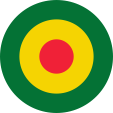 |
Flugzeugkokarde – aircraft roundel Quelle/Source, nach/by Wikipedia (EN) |
Landkarten – Maps: |
Lage – Position: |
Landkarte des Landes – Map of the Country: |
| Zahlen und Fakten – Numbers and Facts: | |
|
|
|
|
|
|
|
|
|
|
|
|
|
|
|
|
|
|
|
|
|
Geschichte: |
| 9.–13.
Jhd. · Teile des heutigen Guinea gehören zum Ghana-Reich 13.–14. Jhd. · Teile des heutigen Guinea gehören zum Mali-Reich, der Islam erreicht Guinea 1450–1460 · die Küste Guineas wird von den Portugiesen entdeckt und erkundet, Portugal errichtet Posten am Rio Pongo und auf der Insel Matakong und bleibt bis zum 18. Jhd. vor Ort 15.–16. Jhd. · das Gebiet des heutigen Guinea gehört zum Fulbe-Reich 16. Jhd. · die Fulbe ziehen sich in das Gebiet von Fouta Djalon zwischen dem Fluss Niger und der Küste zurück und treten zum Islam über 1725 · Errichtung des islamischen Fulbe-Gottesstaats Fouta Djalon 1808–1816 · Großbritannien errichtet Missionsstationen und betreibt Handelsstützpunkte auf den Los-Inseln und am Rio Pongo 1820 · französische Händler erreichen das Küstengebiet von Guinea und treten als Konkurrenten zu den Briten auf 1850–1866 · Franzosen und Briten schließen "Schutz- und Freundschaftsverträge" mit der Küstenbevölkerung 1866 · Frankreich gelingt es durch Verträge die Militärposten von Boké (Rio Nunez), Boffa (Rio Pongo) und Benty (Mellacorée) auf dem Festland zu errichten, und sich dort dauerhaft festzusetzen. Die Los-Inseln verbleiben aber unter britischer Kontrolle. 1870 · im Hinterland (östlich des Niger) bildet sich der Malinkestaat Ouassoulou 1882–1896 · Unterwerfung des gesamten Küstenstreifens (Rivières-du-Sud) von Guinea durch Frankreich 1893 · Bildung der Kolonie Französisch-Guinea 1896–1897 · Unterwerfung von Fouta Djalon durch Frankreich 1898 · Unterwerfung von Ouassoulou durch Frankreich 1904 · die Briten überlassen die Los-Inseln den Franzosen, Angliederung von Französisch-Guinea an Französisch-Westafrika 1946 · Bildung des Überseeterritoriums 1947 · Gründung der PDG (Parti Democratique de Guinee) 1957 · Teilautonomie 02.10.1958 · Unabhängigkeit unter Präsident Sekou Touré (PDG) 1963 · Einführung des Guinea-Franc als neue Währung 1972 · Einführung des Syli als neue Währung 1984 · Tod von Touré, Militärputsch 1991 · neue Verfassung, Wiedereinführung des Guinea-Franc als neue Währung 1993 · erste, jedoch umstrittene, demokratische Präsidentschaftswahlen 1995 · Parlamentswahlen innerhalb eines Mehrparteiensystems 1999–2000 · Konflikte mit Liberia 2008 · Militärputsch 2021 · Militärputsch |
History: |
| 9th–13th
cent. · parts of the today's Guinea belong to the Ghana Empire 13th–14th cent. · parts of the today's Guinea belong to the Mali Empire, the Islam gains Guinea 1450–1460 · the coast of Guinea is discovered and explored by the Portugese, Portugal establishes stations upon the Rio Pongo and on Matakong Island and stands there to the 18th century 15th–16th cent. · the area of the today's Guinea belongs to the Fulbe Empire 16th cent. · the Fulbe retire in the region of Fouta Djalon between the river Niger and the coast and convert to the Islam 1725 · establishment of the islamic Fulbe theocracy of Fouta Djalon 1808–1816 · Great Britain establishes missions and merchant bases on the Los Islands an upon Rio Pongo 1820 · French merchants reach the coast of Guinea and came as competitors to the British 1850–1866 · Frenchmen and the British contract "protection and friendship treaties" with the coastal population 1866 · France succeeds in establishing the military outposts of Boké (Rio Nunez), Boffa (Rio Pongo) and Benty (Mellacorée) on the mainland by treaties. The Los Islands however remain under British influence. 1870 · in the outback (eastern the river Niger) establishes the Malinke State of Ouassoulou 1882–1896 · subjection of the whole coast of Guinea (Rivières-du-Sud) by France 1893 · formation of the French Guinea Colony 1896–1897 · subjection of Fouta Djalon by France 1898 · subjection of Ouassoulou by France 1904 · the British cede the Los Islands to the Frenchmen, affiliation of French Guinea to French Western Afrika 1946 · formation of the Overseas Territory 1947 · foundation of the PDG (Parti Democratique de Guinee) 1957 · partial autonomy 2nd of October in 1958 · independence under president Sekou Touré (PDG) 1963 · introduction of the Guinea Franc as new currency 1972 · introduction of the Syli as new currency 1984 · death of Touré, military coup d'état 1991 · new constitution, re-introduction of the Guinea Franc as new currency 1993 · first, however disputed, democratic presidency elections 1995 · elections for a new parliament within a multi-party-system 1999–2000 · conflicts with Liberia 2008 · military coup d'état 2021 · military coup d'état |
| Quelle/Source: Atlas zur Geschichte, Discovery '97, Weltgeschichte, Wikipedia (D) |
Ursprung des Landesnamens – Origin of the Country's Name: |
|
| Der Name "Guinea" geht auf das Berber-Wort "aguinaou" zurück, was "Schwarze" heißt und sich urspünglich auf alle Bewohner der Westafrikanischen Küste von Senegal bis Gabun bezog. | The name "Guinea" goes back to the Berber word "aguinaou", what means "blacks" and referred originally to all residents of the West African coast from Senegal to Gabon. |
| Quelle/Source: Handbuch der geographischen Namen | |